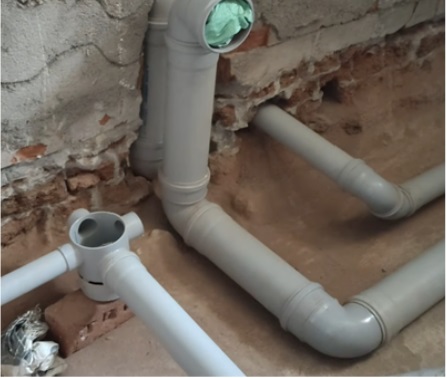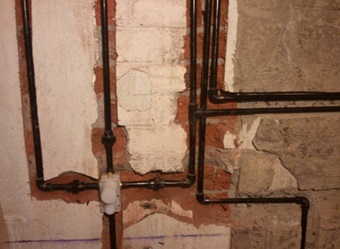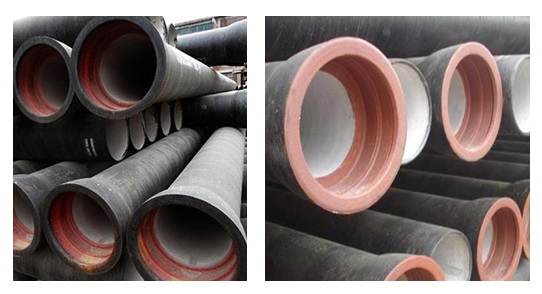
Types Of Plumbing Pipes
Complete Guide To Different Types Of Plumbing Pipes
Different types of plumbing pipes are used for different home improvement and remodel projects. Each of these pipes is made up of different material that offers some unique advantages and the technical features.
The choice of the type of plumbing pipe to be used depends upon the technical features and other requirements for the project.
The plumbing is a broad category that essentially includes two types of pipes. Some plumbing pipes are exclusively used as a water supply pipe. Whereas, some plumbing pipes are used as drainage pipes.
The plumbing pipes can be broadly grouped into two basic types. That is rigid pipe and flexible pipe. Based on the material, the pipe can be PEX pipe, copper pipe, galvanized iron GI pipe, PVC and CPVC pipe.



The plumbing is an essential component of the many home improvement and home renovation projects. The knowledge and understanding of different types of pipes is critical for successful project execution.
The plumbing system is used to supply and regulate the water to various functional areas such as kitchen, bathroom, garden and other such areas. Whereas, the drainage pipes carry the used waste water to the municipal drain.
The strength, recommended use, life and other technical properties of the pipe depends upon the type of material used to manufacture the pipes.
In this article, we will study different types of pipes used in the home construction industry and their technical features suitable for various applications.
Types Of Plumbing Pipes Complete DIY Guide
Plumbing Pipe Types
Complete Guide To Types Of Plumbing Pipes
Table Of Contents
Types Of Plumbing Pipes
The plumbing pipes can be broadly categorized into two main types which include flexible pipes and rigid pipes.
The flexible pipes can easily bend and turn to the required direction. The flexible pipes are becoming increasingly popular.
The flexible pipes are mainly used in the wooden house construction especially in USA and European countries.
The rigid pipes does not offer the flexibility of the flexible pipes. Whereas, the rigid pipes are considered more durable.
The rigid pipes are mainly used in the brick wall house construction especially in the Asian and tropical countries.
The plumbing pipe type also include pipes that are mainly used for water supply lines and pipes that are used as a drainage pipe line works.

Types Of Plumbing Pipes Complete DIY Guide
Water Supply Pipes
The water supply pipes are part of the house plumbing system. The main function of the water supply pipe is to carry the water from the municipal water main to the various plumbing points.
Each service area such as washroom, kitchen and garden area has its own network of water supply pipes connected to the various plumbing fixtures.
Water Supply Pipes

Drainage Pipes

Drainage Pipes
The drainage pipes are part of the house plumbing system. The main function of the drainage pipe is to carry the used waste water from the house to the municipal main drainage line.
Each service area such as washroom, kitchen and garden area has its own network of underground drainage pipes connected to carry the waste water ( Sullage And Sewage ) from various plumbing fixtures.
Types Of Plumbing Pipes Complete DIY Guide
Flexible Pipes
As the name suggest, the flexible pipes are made up of flexible material such as plastic and rubber pipes.
The PEX pipes are flexible pipes extensively used for the house plumbing work. The flexible pipe connectors are extensively used for the washbasin and kitchen sink installation.
Flexible Pipes

Rigid Pipes

Rigid Pipes
The rigid pipes are hard pipes made up of rigid material such as metal pipes , UPVC and CPVC pipes.
The rigid pipes are used for the concealed internal plumbing pipes embedded into the brick wall and plaster. Due to its superior strength , the rigid pipes are also used for outdoor plumbing work.
Types Of Plumbing Pipes Complete DIY Guide
PEX Pipes
The PEX pipes are flexible plumbing pipes and the latest entrant into the plumbing pipes market. The PEX pipes offer ease of pipe installation and advantage of rapid installation.
The PEX pipes are made up of special type of PVC called cross-linked polyethylene material that offer some major advantages to the plumbing pipes.
The PEX pipes are fast replacing the copper plumbing pipes extensively used in the European and American plumbing systems.
The PEX pipes are relatively far less expensive as compared to other types of home plumbing pipes. The easy installation is another major advantage that makes PEX pipes a popular choice for the DIY plumbing projects.
The PEX pipes are used only as a water supply pipe lines.
PEX Water Supply Pipes

PEX Pipes

The PEX pipes are usually available in two colors. The red PEX pipes are used for the hot water installation. Whereas, the blue PEX pipes are used for the cold-water application.
In order to work with PEX pipes, you will need a PEX pipe cutter, special PEX pipe fittings and PEX pipe clamps.
The PEX pipes are available in two types. This include the TYPE A and TYPE B PEX pipes.
TYPE A And TYPE B PEX Pipes
The TYPE A PEX system makes use of a special expandable type of fittings. The type A PEX pipe that does not cause any reduction of the pipe diameter at the joints. And therefore, does not cause any obstruction the pipe flow.
On the other hand, the TYPE B PEX installation use plumbing fittings that is inserted into the pipe and the joint is sealed with a special clamping sleeve used to tighten the joint.
The type B PEX pipe that cause slight reduction of the pipe diameter at the joints that may cause slight reduction into the flow.
Types Of Plumbing Pipes Complete DIY Guide
Copper Pipes
The copper pipes traditionally used to be the most commonly used plumbing pipes especially in the US and European countries.
However, the copper pipes are being fast replaced by other plumbing pipes with the advent of PEX pipes and CPVC pipes.
The copper pipes are relatively far more expensive as compared to other plumbing pipes. Further, the copper pipe also needs a highly skilled plumber.

The typical copper pipe plumbing can use two main types together. The copper pipes are available in two types which include rigid and flexible copper plumbing pipes.
The rigid copper pipes are used as main supply pipes for larger lengths. Whereas the flexible copper pipes are used for short distance usage.
The Size Of the Copper Pipe
Depending upon the requirements, different sizes of the copper pipes are used in the plumbing system. The copper pipe sizes are measured in milometers.
The copper pipe sizes are labelled on the pipe itself. The most commonly used pipe sizes for residential plumbing are 15 mm, 18 mm and 22 mm.
The copper pipes are also available in different thickness used for different applications. There are three grades of thickness available for plumbing applications.
Types Of Plumbing Pipes Complete DIY Guide
Galvanized Iron GI Pipes
The galvanized iron ( GI ) are most commonly referred as GI pipes. The Galvanized iron pipes are manufactured from a special mild steel strips that contain low carbon coil.
The GI pipes are extensively used in the construction industry for different applications. However, the GI pipes are most commonly used as plumbing pipes.
The GI pipes offer excellent corrosion resistance and trouble-free long-life span. The use of GI pipes for house plumbing application is very common in the Asian countries. The GI pipe are not suitable for cold
The Galvanized iron ( GI ) pipes are coated with a special corrosion resistant zinc coating. This zinc coat protects the GI pipes from corrosion. However, one the zinc layer is eroded then the corrosion starts.
GI Water Supply Pipes

Galvanized Iron Plumbing Work

The GI pipes are commercially categorized into three main types based on the technical features.
The class A pipes are marked with yellow band used for light applications. The class B pipes are marked with blue band used for medium applications. Whereas, the class C pipes are marked with red band used for heavy plumbing applications.
The plumbing system with GI pipes requires a skilled plumber. Special threading tools are required to work with GI pipes. The GI plumbing is relatively expensive as compared to the CPVC pipes and also takes considerable time for installation.

GI Pipe Sizes
The most commonly used GI pipe sizes for house plumbing include 0.5 inch, 1 inch, 1.5 inch, 2 inch and 3 inch.
However, half inch GI pipe is the most commonly used pipe for the internal plumbing for the kitchen and bathroom.
The municipal authority issue water supply connection ( diameter size ) based on the estimated demand of the water for a residential apartment.
Types Of Plumbing Pipes Complete DIY Guide
Polyvinyl Chloride PVC Pipe
The polyvinyl chloride ( PVC ) pipes is another common type of plastic pipe available in the market. However, the PVC pipes are not used for the residential plumbing works.
Instead, the CPVC pipes are recommended for the residential plumbing work. However, the PVC pipes are extensively used for home drainage projects such as storm water pipes and drainage line pipes.
The PVC pipes are also extensively used for arbitral pipe line projects. The PVC pipes are relatively much cheaper as compared to other plumbing pipes such as GI pipes or CPVC pipes.
PVC Drain Pipe Sizes

PVC Pipe Plumbing Fittings

As the name suggest, the PVC pipes are made-up of combining the plastic with vinyl to form a thermoplastic polymer.
The PVC pipes are available in different grades that offer relative strength and other properties suitable for different applications.
The PVC pipes are not suitable for handling the high or low temperature water. And therefore, the PVC pipe application is restricted to drain or vent pipes. The PVC pipes offer the cheapest option and the installation process is very easy.

PVC Pipe Sizes
The use of PVC pipes is mainly restricted as drainage pipes. However, the PVC pipes lacks the strength and other properties required for the underground drainage lines.
And therefore, the PVC pipes are extensively used for vertical drainage lines placed on the external façade of the building.
The common size for the storm water vertical pipeline is 3 inches. The vertical drain lines that carry sullage and sewage can be either 3 inch or 4 inch depending upon the work requirements.
Types Of Plumbing Pipes Complete DIY Guide
CPVC Pipe
Chlorinated Polyvinyl Chloride Pipe
The chlorinated polyvinyl chloride ( CPVC ) pipes is another common type of plastic pipe that belongs to the PVC pipe family. However, the CPVC pipes extensively used for the internal and outdoor residential plumbing projects.
The CPVC is a thermoplastic pipe and fitting system made with CPVC compounds that conforms to the standards and requirements of ASTM Class 23447 as defined in ASTM Specification D1784.
The CPVC pipes are manufactured from special chemical compounds that imparts desirable properties to the CPVC pipes.
The CPVC pipes can easily withstand wide range of cold and hot temperatures. Theses pipes can handle very high temperature as well as very cold temperature water.
The CPVC pipes composition is altered by a free radical chlorination reaction. This special treatment effectively increases the chlorine content of the base material used to manufacture these pipes.
CPVC Plumbing Pipes

CPVC Pipe Plumbing Fittings

The CPVC pipes offer excellent strength, impact resistance, corrosion, frost and temperature resistance.
The CPVC pipes have become industry standard for the concealed plumbing pipeline. The CPVC pipes can easily be used for the concealed plumbing work embedded into the brick wall as water supply pipes.
And therefore, the CPVC pipes are becoming a preferred choice for all types of residential plumbing projects. The CPVC pipes are fast replacing the GI pipes for the residential plumbing work.

CPVC Pipe Sizes
The most commonly used CPVC pipes for house plumbing include 0.5 inch, 1 inch, 1.5 inch, 2 inch and 3 inch.
However, half inch CPVC pipe is the most commonly used pipe for internal plumbing work for the kitchen and bathroom.
However, the GI pipe still a preferred choice for the outdoor plumbing work. Especially as a connection pipe connected to the municipal water main placed outside the building premises.
Types Of Plumbing Pipes Complete DIY Guide
Cast Iron CI Pipe
The cast iron ( CI ) pipes is another common name in the plumbing pipes. The use of cast iron has declined over a period of time due to advent of better options.
However, the cast iron pipes are still in use especially for the distribution network pipelines running along the streets for water supply lines in the city.
The cast iron pipes are made up of cast iron that offer excellent strength and the durability. The cast iron pipes also excellent running water noise cancellation as compared to PVC or CPVC pipes.
The cast iron pipes are used as drainage pipe line pipes. The CI pipes are relatively very expensive as compared to PVC and CPVC pipes. The CI pipe line installation also needs a skilled plumber.

The CI pipes lifespan is affected by the corrosion and these pipes tend to develop pin holes over a period of time due to corrosion.
The Cast iron pipe used to be a common piping material for drainage systems, particularly in the first half of the twentieth century, and it can still be found in many homes today.
The cast iron pipes are very strong, durable and heavy. These pipes also reduce the sound and can easily handle wide range of temperatures.
Despite the advantages of strength and durability, though, a big disadvantage of the cast iron pipe is that it is susceptible to rust over time.
Types Of Plumbing Pipes Complete DIY Guide
Concrete Pipes
The concrete pipes are made-up of concrete of specific grade. The concrete is a mixture of cement, course and fine aggregates and water.
The concrete pipes are manufacture by using different construction techniques. The concrete pipes are reinforced with still bar reinforcement which imparts tensile strength to the cement concrete.
The concrete pipes are mainly used as drainage pipeline. Most drainage pipelines installed by the municipal authorities are concrete pipes.
However, the concrete pipes can also be used for the drainage pipeline work for the residential building.
The common sizes of the concrete pipe starts from 6 inch and the large size concrete can be of few feet diameter as per the project requirements.
Concrete Pipes

Concrete Pipes

Types Of Plumbing Pipes Complete DIY Guide
Stoneware Pipes
The stoneware pipes are a special type of drain pipes manufactured from a special type of soil mixture. The soil mixture is placed in pipe moulds and fired at high temperature.
It is a vitreous or semi-vitreous ceramic made primarily from stoneware clay or non-refractory fire clay.
The stoneware pipe external surface has glazed appearance and therefore absorb minimum water. This property of the stoneware makes it suitable for manufacturing the plumbing pipes.
However, the stoneware being a brittle material, the stoneware pipes are relatively small in sizes and the length is also restricted for the easy transportation.
The stoneware pipes are available 6 inch and 9 inch diameter and the length is restricted to 24 inch. However, these pipes are now being fast replaced by other PVC , CPVC , CI and the concrete pipes.





